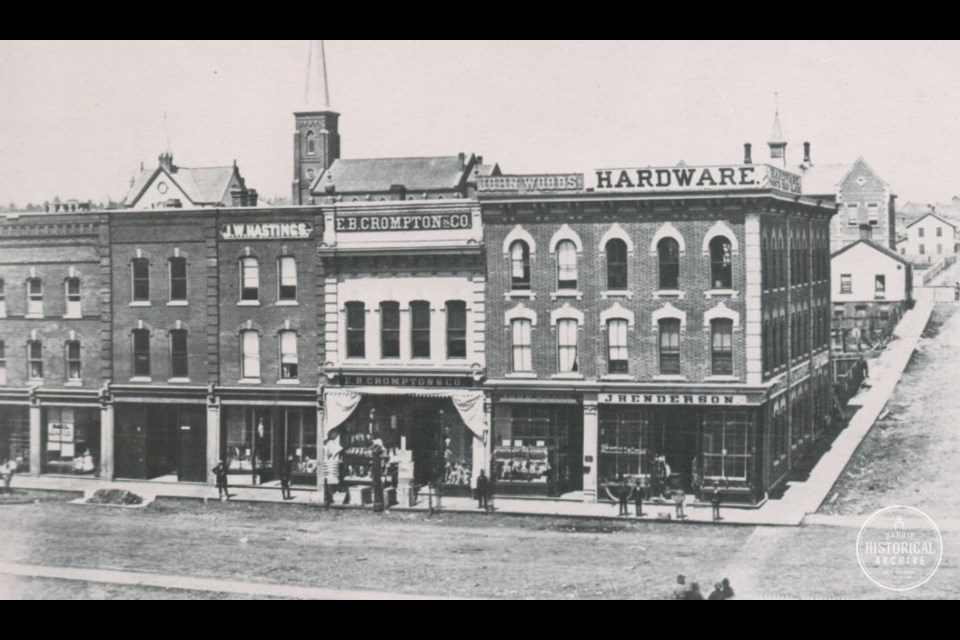From the time photography was invented, practitioners of the art were constantly trying to improve its processes.
They saw this new technology was going to be huge, but with hours-long exposure times, it was not going to go anywhere unless it was made user friendly for the paying public.
By the 1860s, exposure times had been drastically reduced, better methods had been found, and the chemicals and printing papers required became more or less standardized.
In the small town of Barrie, one of the first to set himself up as a photographer was David Brassingdale ‘D.B.’ Garton. Garton was a carpenter by trade.
Like many merchants of the time, Garton offered a variety of goods and services under one roof. In addition to carpentry work, he was the county agent for Spratt’s Lightning Rods, and was a dealer in picture frames, lockets and photograph albums.
In early 1863, Garton asked a group of businessmen into his shop. A Northern Advance reporter was among the attendees and penned a piece for the April 8 edition of the paper.
“We were invited by Mr. Garton of this town to examine his photographs and to submit to the operation. Mr. Garton has his rooms fitted up with every convenience for taking likenesses and is very successful with his pictures; the portraits on hand, decidedly superior to the average of those country practitioners, compare favourably with anything we have seen exhibited in Toronto.”
Naturally, it was not long before Garton had competitors. The partnership of John Thompson and George Lynn arrived on the scene about 1867. They offered colour photographs, which would be achieved through the addition of either oil paints or India ink.
In 1872, John Stephens arrived in town. This photographer would long dominate the industry in Barrie and would eventually hand over the reins to his son-in-law, J. Frank Jackson, who would also make a decades-long career in the photography business.
When W.C. Reeves set up a photo studio in 1877, the competition between he and Stephens became quite fierce. Reeves’s advertisements in the Northern Advance held nothing back.
“My opponent, Stephens, in the tintype gallery, endeavours to convey that he got a prize for photographs. Now, his statement is FALSE, which anyone can see by reading the judges’ report in the three Barrie papers on October 9th, 1879. He is ASHAMED to inform the public that he only got a ticket for tintypes because he was the only one who showed pot-metal pictures. Had anyone else competed for that kind of picture, the tintype man would have been left out in the cold.”
In 1889, Reeves discontinued his business and Stephens did not miss his chance to gloat just a little bit.
“Another man shot! And still Stephens the Photographer is not leaving town but has bought all of Mr. Reeves’ negatives.” To which he added a few more parting words: “Victory is mine. Nothing like success.”
The Barraud Bros. were prominent photographers in Barrie during the 1880s. In 1888, the Barrauds left for the United States. The family name remained on the business, but it was Swithin King who was running the studio from that time until the mid-1890s.
Also operating during the 1890s was Hurst, who had a photo studio on Dunlop Street just east of Owen Street. He suffered losses during a fire in 1895 and his name disappeared from the newspaper advertising pages.
In 1896, Stephens had been retired for five years, but he could not resist jumping back into the photography business when he saw the opportunity to buy the Barraud-King studio.
“Stephens the Photographer is under the skylight again. After a rest of some time, having purchased the Barraud and King Studio and contents.”
One year later, Stephens retired for good and sold the business to the Shaw Bros. photography company.
W.R. Keenan dabbled in photography around 1900 and then went into shopkeeping and ran the West-End News Agent store on Elizabeth Street.
As you can see, the small town of Barrie, barely removed from its backwoods days, had no shortage of photographic artists. My only complaint is inscribing the names on the back of their work never became a common practice. Oh, how I wish.
Each week, the Barrie Historical Archive provides BarrieToday readers with a glimpse of the city’s past. This unique column features photos and stories from years gone by and is sure to appeal to the historian in each of us.

